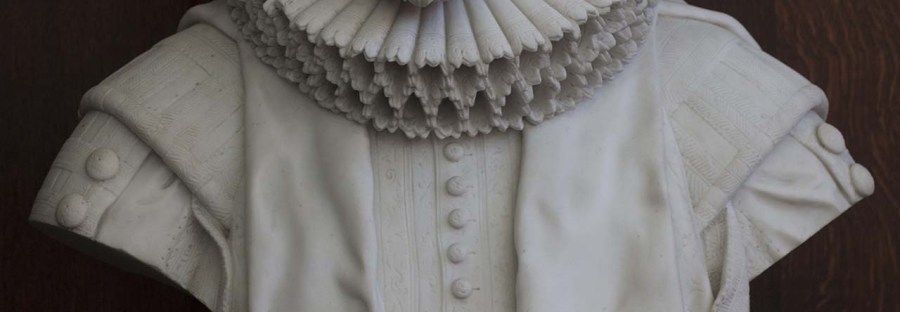
Credit: Wikimedia Commons
The Wren Library houses a magnificent series of portrait busts by Louis François Roubiliac, the leading sculptor in England in the mid-18th century.
By Wren’s time, there was a well-established tradition of furnishing libraries with painted and sculptural portraits. The subjects of these portraits would often be ancient and modern authors, great men worthy of emulation and providers of inspiration. This can be seen in the Wren in the series of plaster and wood busts placed on top of the bookcases on either side, one side ancient, one side modern. Together with representations of authors, portrait busts were also made of illustrious former members of College as a means of honouring them as well as helping to construct a sense of the College’s institutional history. It is in the series of busts which line either side of the Wren at floor level, each on a plinth, that we find the glorious workings of Roubiliac.

While figurative sculpture for the interior of the Library had been envisaged by Wren, this was not realised to any scale until the middle of the eighteenth century when it became part of a wider project to ‘define and articulate Trinity’s intellectual affiliations and identity’ [1]. Enter Roubiliac.
By the 1750s he had established his reputation as one of the best sculptors in England. He was appreciated not only for his mimetic skills but also for his inventiveness, the latter which enabled him to stand out from rivals like John Michael Rysbrack and Peter Scheemakers. Probably the first thing that impresses as you gaze upon one of Roubiliac’s busts [in the Wren Library] is a delightful synesthesia conjured up in the immediacy of encountering the subject of the bust as if in person, a person who emerges from marble that, far from being cold and static, seems to flow around the contours of the face, hair and upper torso, and is suffused with warmth. There is a pleasing symmetry to the busts, from the head out to the shoulders and in again to the socle at the base. As Malcolm Baker expresses it in his invaluable chapter on the portrait sculpture in the Wren, they are created to be viewed as works of art in their own right and not merely as sculptures with a public function.
It is thus not surprising that it is to Roubiliac that the Master, Robert Smith, and Fellows of Trinity turned when they were embarking on a programme to develop the College’s iconography. This programme was guided by Smith’s own interests, particularly in the sciences, and was by no means confined only to the Library, or only to works of sculpture, but encompassed various forms of portraiture arranged throughout the College. There is no evidence to suggest a coherent plan, however. In the Library, the busts were either donated or commissioned by former members or friends of College, at the instigation of Smith; the combination of busts that resulted was down, in the end, to who he succeeded in persuading.
The busts in the Wren Library comprise:
10 by Roubiliac, the earliest being those of Isaac Newton, Francis Bacon, Francis Willoughby or Willughby and John Ray. These are placed in pairs at either end of the Library. Later additions include Isaac Barrow, Richard Bentley, Baron Trevor, Lord Whitworth, Sir Robert Cotton and Sir Edward Coke. There are also two by Scheemakers and one by John Bacon.
Each bust is inscribed with the name of the sculptor, sitter and donor, and a date.
The final resting place of all 10 Roubiliac busts in the Wren Library was not established until into the 19th century. While we know that the busts of Newton, Bacon, Ray and Willoughby had been placed in the Library in the 1750s, and the bust of Cotes by the first decade of the following century, guidebooks and accounts do not mention the other busts until the 1830s, and so these had probably been placed elsewhere in College.
The Roubiliac busts
References:
1. Baker, Malcolm. ‘The portrait sculpture’: in ‘The making of the Wren Library’, edited by D. McKitterick, p. 110.
Further reading:
Esdaile, K.A. Roubiliac’s work at Trinity College Cambridge.
Esdaile, K.A. The life and works of Louis Francois Roubiliac.
Bindman, David. Roubiliac and the eighteenth-century monument.












Excellent, and do bring us more on Trinity’s works of art. (1971 Matriculation)
Pingback: Discovering Newton – Trinity College Library, Cambridge
Pingback: “… touches the very soul of anyone who first sees it” : the woodcarvings of Grinling Gibbons in the Wren Library – Trinity College Library, Cambridge
Pingback: Thorvaldsen’s Statue of Byron – Trinity College Library, Cambridge
Pingback: Portraits in the Wren Library – Trinity College Library, Cambridge